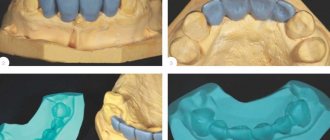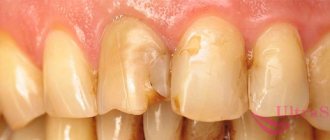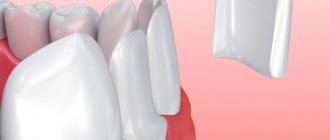Service cost from
8 700 ₽
We accept bank cards
Payment on credit or in installments Installments or credit for a comprehensive treatment plan are possible
Make an appointment
View full price list for services
- Prices
- Work examples
- Questions and answers
- Stock
- Reviews
- Kinds
- Installation
Dental veneers are small overlays that have become widespread in aesthetic dentistry due to their many advantages and affordability.
What are veneers
These are thin, custom-made ceramic plates to preserve the tooth and restore its aesthetic function. They allow you to correct various defects without surgery or serious treatment. This method is suitable for most patients suffering from external defects or yellowed enamel.
This is an excellent material for creating an ideal smile - they cannot be stained, do not change their shape, retain their texture, and also have the shine of natural teeth. It should be noted that they are highly biocompatible and absolutely safe for health, and high-quality modern materials and manufacturing technologies make them strong, durable and wear-resistant.
Examples of work “Before” and “After”
Gap between the front teeth - diastema
Case: Gap between the teeth and complaints about the aesthetics of the smile Work: 6 Empress Esthetic veneers on the front teeth and a metal-ceramic bridge on the lateral chewing teeth on the left Time: 6 days Number of visits: 3 Cost: 135,000 rub.
Restoration of anterior teeth with Empress veneers
Case: the patient complained of unsatisfactory aesthetics of the front teeth and a gap between the teeth.
Restoration of front teeth with ceramic veneers (May 2012)
Case: I went to the clinic with a complaint about the unsightly shape and position of the central incisors on the upper jaw.
Restoring aesthetics with lumineers
Case: the patient complained of unsatisfactory aesthetics of the anterior teeth (yellow enamel, curvature).
Benefits of veneers
- Natural appearance. During the first appointment, the orthopedic dentist will take impressions and send them to the laboratory, where they will be made. They will match the enamel color to the contour of your natural teeth. The veneer design will be tailored to your facial symmetry and overall style. Each onlay, if you plan to install several pieces, is made separately and attached individually to the tooth surface.
- Minimal impact on the tooth. Compared to other prosthetic methods, installation is the least traumatic. According to statistics, the dentist removes a layer of topcoat less than 0.5 millimeters thick.
- Quick solution to cosmetic problems. In some cases, they are an alternative to installing braces. Many patients prefer to “close” the problem rather than spend many months moving their teeth to straighten them.
- Durability. Greater ability to resist decay and staining than natural teeth.
- Easy to care for. You do not need any special procedures or devices for grooming. The same hygiene - brushing twice a day and flossing.
Reviews
I have had a small chip on my front incisor since school. I did the restoration many times - on average once every 2 years. The procedure is inexpensive and lasts a long time. Therefore, I have already refused the dentist’s offer to install ceramics many times. In addition, I don’t want to grind down the tooth, because then it will be simply impossible to leave it without microprostheses.
Sergey, Kaliningrad
I had a canine tooth restored for the first time 3 years ago. This effect only lasted me 2 years. a chip in the same place fell off while eating. This prospect of debris did not suit me, so I ordered veneers. We placed onlays on two symmetrical teeth so that they would not differ much from each other. I've been wearing them for almost a year now, no complaints.
Peter, Samara
Stages of installing veneers
Typically three visits to the dentist are required - one for consultation and two for fabrication, fitting and installation. At the same time, the doctor can work with several teeth or with one.
- Diagnosis and treatment planning
At the first meeting with the patient, the doctor will identify your needs and determine the result you want to achieve. A prosthodontist, or prosthodontist, will examine your teeth to make sure veneers are right for you. Will discuss the installation procedure and some of its limitations and features in your individual case. At your appointment, you will definitely have an x-ray and an impression taken if you are ready to begin treatment.
- Preparatory stage
To prepare the tooth, you need to grind its surface to the thickness of the veneer. This allows for ergonomic placement of the pads without additional discomfort. Impressions and wax-up of a prototype of your vax-up smile are then made. The production time in the laboratory ranges from 10 to 28 days. You will wear temporary pads while you wait.
- Prototype your smile without grinding down the enamel
At the Stimul Clinic, it is possible to undergo a clinical intermediate stage for the patient to evaluate the functionality and aesthetics of future veneers. The so-called fitting of a smile without grinding down the enamel. Mock up a smile is the application of wax plates for imitation. You can wear the plates for several days. Smile, take pictures, get used to a new smile. This stage guarantees predictability of the result for both the patient and the doctor.
- Installation of permanent veneers
The final stage is fitting and installation. The doctor will make repeated adjustments to achieve the perfect fit before permanently securing it. Immediately before installation, the final stage of tooth processing takes place and the onlay is attached to the surface with a special material. Under the light beam, chemicals are activated, resulting in strong adhesion to the surface. Finally, the doctor will check your bite, make minor adjustments if necessary, and your smile is ready!
There are two ways to make them in modern dentistry:
— The first of these is the indirect method of making veneers, which are made in a laboratory. Before installing them, the tooth is sharpened a little and then an impression of the patient’s teeth is made. The production of porcelain attachments will take no more than two weeks, but in the meantime the doctor will install temporary crowns on the patient’s ground teeth. Veneers are installed on prepared teeth using special glue.
— Direct veneers are made from composite materials. They are directly applied to the tooth surface one layer after another. After installation, the tooth is ground and as a result they are transparent and natural, but such straight overlays last no more than five years.
Ceramic tooth inlay in Krasnodar
One of the achievements of modern dentistry has become the possibility of using inlays on teeth . They are used to restore the dental crown of severely damaged teeth. There are inlays made from various materials, which have their pros and cons. But one of the best is considered to be a ceramic tooth inlay. What is its advantage, and in what cases is it necessary? Let's try to answer these questions.
A dental inlay, like a filling, is needed to restore a tooth damaged by caries to its normal appearance. But its difference is that the inlay is made not in the oral cavity, like a regular filling, but in a special laboratory.
Such inlays are used both separately and in combination for dental prosthetics. Ceramic products have shown their best performance to date. Firstly, it is high quality and durable in use. And secondly, of course it’s aesthetics. With the help of inlays, dentists can correct your bite and make your smile incredibly attractive. This is especially true for the use of inlays on the front teeth. Such inlays are called veneers. Externally, ceramic inlays look like porcelain. They are simply irreplaceable for the restoration of front teeth.
There are several types of ceramic inserts. Zirconium dioxide inlays are especially durable. They are as strong as metal.
Inlays can also be made from pressed ceramics. While looking ideal from an aesthetic point of view, they are still inferior in strength to products made from zirconium.
The third type of inlays is metal-ceramic. In appearance, such inlays are undoubtedly superior to conventional fillings, but they are not the most reliable when it comes to their durability.
Today, more and more dentists are working with inlay dental restoration technology. Thus, it is possible to restore only the outer part of the tooth or its stump if the tooth is severely damaged and the root is healthy. But it should be noted that in the second case, a crown or even a bridge will be attached to the tab.
Inlays make it possible to achieve not only a high aesthetic appearance of teeth, but also to seal large cavities in the teeth.
Ceramic dental inlays are resistant to dyes and are in very close contact with the walls of the tooth. This prevents the development of caries.
Unlike fillings, they are extremely durable and highly durable. Ceramic inlay is several times stronger than brick.
There are practically no downsides to dental inlays. The only thing is that such an inlay cannot be installed on a tooth that is destroyed by more than 60% and does not have two walls. In this case, it is necessary to install a crown.
It is also not advisable to place inlays on baby teeth and wisdom teeth. They are not installed even if there is a carious lesion in the oral cavity.
Of course, installing an inlay will take longer than a regular filling. But the result is worth it.
Many clients ask if any special care is needed after installing a dental inlay. Not really. No special care other than normal high-quality oral hygiene is required.
You can get more detailed advice on everything related to ceramic inlays for teeth at the Santi dental clinic in Krasnodar. Contact us! Our specialists will carry out high-quality restoration of damaged teeth using a ceramic inlay.
Our doctors
Pavlova Elena Vitalievna
Shmidt Pavel Andreevich
Asochakova Sofia Pavlovna
Mikhalchenko Olga Ivanovna
Kritskaya Anastasia Nikolaevna
Make an appointment
Please fill out this form and submit your application. Our managers will contact you shortly.
Stages of dental restoration
First of all, you need to consult a dentist in the therapeutic department. He will assess the condition of the tooth, gums, and bone tissue, after which he will give recommendations on the method of restoration and, if necessary, send the patient to a procedure for professional sanitation of the oral cavity and treatment of caries.
Everything is very individual. The slightest characteristics of the patient influence how the restoration will be carried out: by building teeth onto a pin, installing onlays, installing an implant or crown.
After this, in accordance with the chosen method of tooth replacement or aesthetic extension, the patient will be sent for the procedure.
Proper care
Once installed, composite or other veneers require careful care. You cannot bite hard food, limit traumatic effects and the influence of external factors. It is forbidden to bite foreign objects.
The patient must take good care of his teeth. Use toothbrushes, floss and irrigators. In addition, veneers need polishing. This procedure is performed by a dentist. Once every six months you need to undergo a doctor’s examination and, if necessary, make corrections to the composite veneer. With proper care, the service life of the linings will be long.











